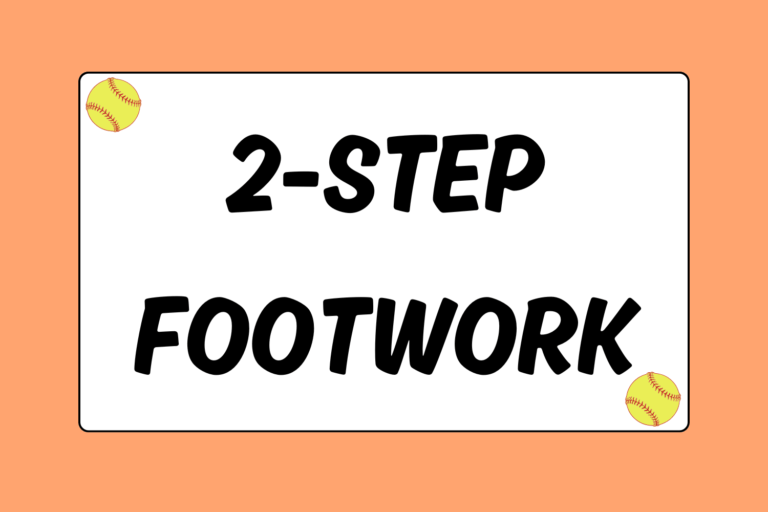A drag bunt is most often utilized by left-handed batters, with the goal of essentially dragging the ball with them as they start running through the box. As a leftie, you will be moving your feet in the box before you bunt the ball so you really have to focus on softening the bunt.
It takes incredible skill to be able to absorb the ball as you are running towards it. But, don’t worry! This guide will give you the basic technique of drag bunting. Read on and have fun!
Note: Basic bunting techniques are grounded in softball’s most standard bunt — the sacrifice bunt. If you need a refresher course on proper bunting technique, check out our guide on How to Sacrifice Bunt.
Footwork for a Drag Bunt
The footwork for a drag bunt is very important for lefties. If it’s wrong, you might be late and you’ll inevitably drag the ball foul or miss it altogether. If your footwork is too early, you’ll be extremely off-balance (or already out of the box) as you wait for the pitch.
Here is the basic footwork for a drag bunt:
- Start at the back of the box. Your hands will be up as if you are going to hit.
- Use the pitcher’s motion as your timing mechanism. Know her speed. If she is quick, you will start your footwork a little earlier. If she is slow, you might even wait until her motion is completely through before starting your feet. For the average pitcher, you will start your footwork when she is throwing her arm backwards before lunging forward.
- With your front foot, take a slight step towards your back foot. This step is like a trigger; it sets your entire body in motion.
- After the first step back, you will step forward (and over) with your back leg. As you do this, bring your hands forward into the bunting position.
How you step with your feet is crucial, so make sure you are following these tips:
- Your toes should always be pointed forwards toward the plate — never towards the pitcher. This will ensure that your shoulders stay closed to the plate.
- Watch your stride. Your first trigger step backwards is small. Your second step with your back leg is much larger. Your weight will naturally shift forward as your back leg crosses over and steps forward. This is the position from which you’ll bunt the ball.
- After you make contact with the ball, you will stride through with your (now) back leg (stepping behind your front leg) and start running down the first base line.
Hand Position for a Drag Bunt
Your hands are just as critical as your feet for a drag bunt. But remember, your feet move first! There are two ways to position your arms and the bat for a drag bunt. For both options, though, it’s important to drop your hands as your back leg is crossing over your front leg (after the trigger step).
Remember, keep your shoulders squared to the plate. Do not open your shoulders towards the pitcher — ever! Your front shoulder should always be facing the pitcher so your body is always sideways. When you go forward through the box, your front shoulder will always be leading you and pointed towards the pitcher!
Hot Tip: One-Handed Drag Bunt
If you really want to surprise the infield, try a one-handed drag bunt. The footwork is the same, but when you put your bat out, you will do so with only your top hand. Make sure your grip is strong!
The Basic Form
The basic way to drop your hands for a drag bunt is to drop your hands in front of your body. Your back arm will be in the “L” position, while your front arm will be bent at the elbow (which will be near the outside of your body) and extended across your stomach.
Your hands will also be closer together on the handle. As with every bunt, keep your bat close to your body and at an angle.
The Advanced Form
There is another way to drop your hands for the drag bunt, and it’s a little more advanced. Drop your hands straight down rather than forward. Your bat’s handle stays behind your back hip. This means that your back arm will make the “L” shape, but it will be facing out and away from your body.
Your elbow will be near your back hip and your forearm extended outwards, parallel to the front of the batter’s box. Your front arm will simply drop down so that it extends across your body (your elbow will be bent in front of the middle of your stomach). Your hands will also be closer together on the handle.
It’s crucial that you keep your eye on the ball because not only are your hands and bat behind you, but your bat will likely be more flat than angled. Keep the ball down!
Proper bat placement should almost guarantee that the ball falls softly in front of the plate, dragged only slightly towards the first base line. It also ensures that you’re showing the bunt at the last possible second.
Hot tip: Read the Infield
All good bunters have something in common: They know how to read their infield. If you see the first and third basemen sitting back on their heels, do not push bunt. From that position, they’re unlikely to be able to get to a soft bunt in time.
Conversely, if you see them crashing hard, push it right past them! They’ll be coming too fast to stop a ball from propelling past them.
Also, look at the corner infielders’ speed and the strength and accuracy of their throws. If the third baseman looks a little slow, place a bunt towards her. Likewise, if the first baseman looks a little slow, bunt it towards her.
Tips
If you are having trouble getting the ball down from behind you, it’s always best to practice without a bat in your hand. Instead, simply put a glove on. With the elbow of your back arm on your back hip, and your forearm extended outwards and parallel to the front of the batter’s box, practice your footwork.
Have someone pitch a ball to you, and practice catching it while keeping your back arm in this position — always keep your shoulders squared to the plate! Bend your knees for anything low. If you do this correctly, every catch should be made behind you on your back hip.
Surprise, Surprise
A drag bunt is supposed to be a surprise for the defense. Remember to keep your hands high (like you are hitting) as long as possible. Drop your hands at the very last moment, and the defense won’t have a chance! From the left-hand batter’s box, you can drag the ball with you or push it, so always be reading the infield. If you are fast and smart, you’ll be a threat to any team!





